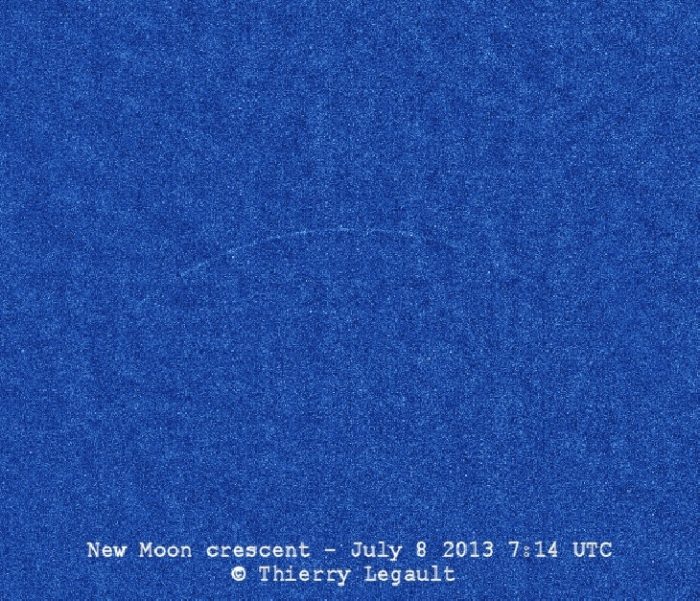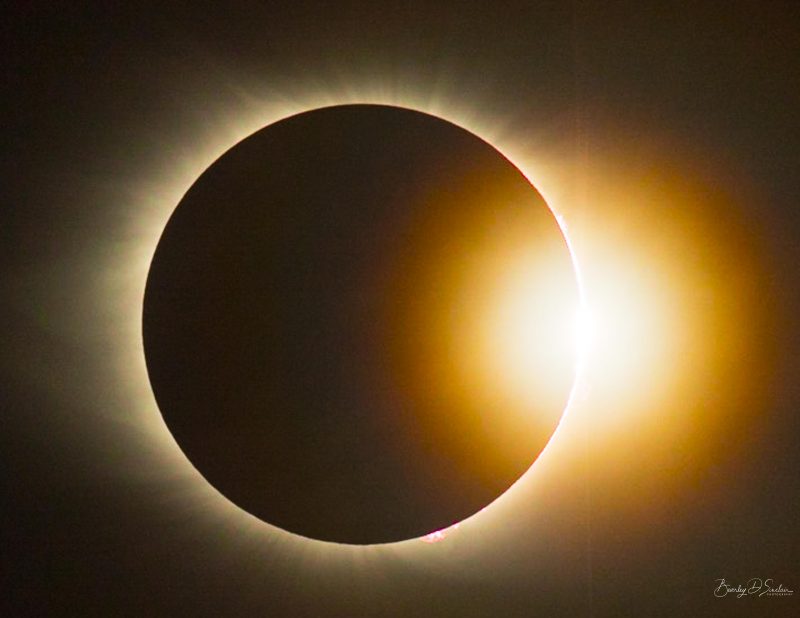

Youngest possible lunar crescent, with the moon’s age being exactly zero when this photo was taken — at the instant of new moon – 07:14 UTC on July 8, 2013. Image by Thierry Legault.
When the moon is most nearly between the Earth and sun for any particular month, astronomers say it is new.
We don’t see a new moon in the sky, unless there’s a solar eclipse, with the moon directly in front of the sun. The image above shows a new moon, not in eclipse, but taken by an expert using special equipment.
Most of the time, the new moon passes not in front of the sun, but simply near it in our sky. Either way – in front of the sun or just near it – on the day of new moon, the moon travels across the sky with the sun during the day, hidden in the sun’s glare.
In the language of astronomy – a day or two after each month’s new moon – a slim crescent moon always becomes visible in the west after sunset. Astronomers call this slim crescent a young moon.
New moons, and young moons, are fascinating to many. The Farmer’s Almanac, for example, still offers information on gardening by the moon. And many cultures have holidays based on moon phases.
And, of course, many look forward to the return of the moon to the evening sky. This always happens a day or two after new moon.

Most of us will never see a new moon, unless we witness a total solar eclipse. Here’s a new moon covering the sun, in an eclipse that swept across the continental U.S. on August 21, 2017. Beverley Sinclair, who saw the 2017 eclipse outside Charleston, South Carolina, wrote: “The skies were very cloudy leading up to totality but, miraculously, slowly cleared as totality approached. This photo shows the diamond ring and Bailey’s beads.”
As the moon orbits Earth, it changes phase in an orderly way. Follow the link below to understand the phases of the moon.
New moon
Waxing crescent moon
First quarter moon
Waxing gibbous moon
Full moon
Waning gibbous moon
Last quarter moon
Waning crescent moon
Read more: 4 keys to understanding moon phases
Bottom line: The next new moon is September 9, 2018, at 18:01 UTC; translate UTC to your time.
Check out EarthSky’s guide to the bright planets.
Help EarthSky keep going! Please donate.
from EarthSky https://ift.tt/19T9DUm


Youngest possible lunar crescent, with the moon’s age being exactly zero when this photo was taken — at the instant of new moon – 07:14 UTC on July 8, 2013. Image by Thierry Legault.
When the moon is most nearly between the Earth and sun for any particular month, astronomers say it is new.
We don’t see a new moon in the sky, unless there’s a solar eclipse, with the moon directly in front of the sun. The image above shows a new moon, not in eclipse, but taken by an expert using special equipment.
Most of the time, the new moon passes not in front of the sun, but simply near it in our sky. Either way – in front of the sun or just near it – on the day of new moon, the moon travels across the sky with the sun during the day, hidden in the sun’s glare.
In the language of astronomy – a day or two after each month’s new moon – a slim crescent moon always becomes visible in the west after sunset. Astronomers call this slim crescent a young moon.
New moons, and young moons, are fascinating to many. The Farmer’s Almanac, for example, still offers information on gardening by the moon. And many cultures have holidays based on moon phases.
And, of course, many look forward to the return of the moon to the evening sky. This always happens a day or two after new moon.

Most of us will never see a new moon, unless we witness a total solar eclipse. Here’s a new moon covering the sun, in an eclipse that swept across the continental U.S. on August 21, 2017. Beverley Sinclair, who saw the 2017 eclipse outside Charleston, South Carolina, wrote: “The skies were very cloudy leading up to totality but, miraculously, slowly cleared as totality approached. This photo shows the diamond ring and Bailey’s beads.”
As the moon orbits Earth, it changes phase in an orderly way. Follow the link below to understand the phases of the moon.
New moon
Waxing crescent moon
First quarter moon
Waxing gibbous moon
Full moon
Waning gibbous moon
Last quarter moon
Waning crescent moon
Read more: 4 keys to understanding moon phases
Bottom line: The next new moon is September 9, 2018, at 18:01 UTC; translate UTC to your time.
Check out EarthSky’s guide to the bright planets.
Help EarthSky keep going! Please donate.
from EarthSky https://ift.tt/19T9DUm

Aucun commentaire:
Enregistrer un commentaire